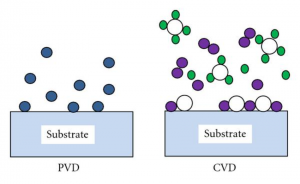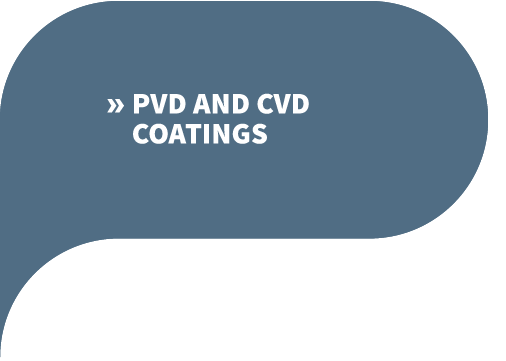PVD vs. CVD: What’s the difference?
In recent years, physical vapor deposition (PVD) and chemical vapor deposition (PVD) have wide applications in various industries to increase the hardness of tools and molds or apply beautiful colors to the products. Thus these two methods are considered as the most attractive surface coating technologies. Then, using the example of cutting tools, let’s make a detailed comparison between these two methods.
Definition
Physical vapor deposition (PVD) uses low-voltage, high-current arc discharge technology under vacuum conditions to evaporate the target and ionize the vaporized material and the gas, and finally make the evaporated material and its reaction deposited on the workpiece.
Chemical vapor deposition (CVD) refers to a process in which a vapor, containing a gaseous reactant or a liquid reactant constituting a thin film element, and other gases required for the reaction are introduced into a reaction chamber to chemically react on the surface of the substrate to form a thin film.

From their definitions, we can clearly see the difference of PVD and CVD that the former involves evaporation of the material from gas phase to solid phase, while the latter includes chemical reaction. And that’s how they got their names—physical and chemical.
Process and Equipment
-
Temperature
I put temperature in the first place because it is the main difference between PVD and CVD. The process temperature of CVD method is very high, usually exceeds the tempering temperature of the high speed steel. Thus in order to restore the hardness, the tools must be subjected to vacuum heat treatment after coating.
-
Cleaning requirement
The cleaning requirements of PVD process for the tool entering the reactor are higher than that of CVD.
-
Film thickness
The CVD coating (about 7.5 μm) on the surface of the tool is thicker than the PVD coating (about 2.5 μm). So it is also a factor to be considered when you are choosing the coating method.
-
Surface
The PVD coating well reflects the surface of the tool and has a good metallic luster without grinding. However, the surface of the CVD coating is slightly rougher than the surface of the substrate.
-
The crafting process
Nearly all PVD technologies have poor coating performance both on the back and sides of the tool due to low air pressure. The PVD reactor must reduce the loading density to avoid shadow formation, and the loading and fixing are complicated. In a PVD reactor, the tool usually rotates continuously, and sometimes it needs to reciprocate while turning.
In contrast, CVD occurs in a low-vacuum gaseous environment and has good coating performance. Therefore, except for the support points, all the surfaces of the cutters sealed in the reactor, even deep holes and inner walls, can be completely coated.
-
Cost
The initial equipment investment of PVD is much higher–3 to 4 times of CVD, but the production cycle of PVD process is lower–1/10 of CVD. In addition, CVD can process a wide variety of workpieces, while PVD is greatly limited. In other words, PVD is sometimes more expensive than CVD.
-
Safety
PVD is a kind of “green engineering”, which produces little pollution during the process because it is “physical”. In contrast, the reactive gas and reaction tail gas of CVD may have certain corrosiveness, flammability and toxicity, and there may be powdery and fragmented substances in the reaction tail gas, so certain measures must be taken for equipment, environment and operators.
Both of physical vapor deposition and chemical vapor deposition have their own advantages. And you have to consider many factors while choosing the coating methods. For more information, please visit https://www.sputtertargets.net/.
Related: What are the uses of Physical Vapor Deposition coating


I have to point out my respect for your kind-heartedness supporting people that need help on your field. Your personal dedication to getting the solution all through turned out to be really important and has without exception encouraged many people much like me to arrive at their endeavors. The interesting guide entails much to me and further more to my office workers. Regards; from everyone of us.
Thanks for all of the efforts on this blog. Gloria enjoys getting into investigation and it is simple to grasp why. Many of us notice all of the compelling method you produce useful techniques on your web blog and therefore increase participation from other people about this concept while our favorite girl is without a doubt being taught a whole lot. Take advantage of the rest of the new year. You are always performing a useful job.
I’m just writing to let you understand of the wonderful encounter my cousin’s daughter gained checking yuor web blog. She picked up so many details, including how it is like to have an incredible teaching style to have folks completely grasp chosen tricky issues. You undoubtedly exceeded people’s expected results. I appreciate you for providing these insightful, trustworthy, educational and also fun tips about the topic to Gloria.
I am forever thought about this, regards for posting.
I as well as my buddies were going through the excellent tricks located on your web page and so quickly I had an awful suspicion I had not expressed respect to the site owner for those techniques. Those women ended up consequently thrilled to read through them and have now honestly been making the most of them. We appreciate you being so helpful and for opting for certain superior information most people are really needing to understand about. My honest regret for not saying thanks to sooner.
I simply desired to appreciate you once more. I’m not certain the things that I might have made to happen in the absence of the ways contributed by you relating to that subject. It had become an absolute traumatic difficulty in my circumstances, but noticing the expert strategy you managed that forced me to cry with joy. Extremely thankful for the work and as well , pray you realize what a powerful job you happen to be accomplishing teaching other individuals via your webpage. Most likely you have never met all of us.
Thanks so much for giving everyone an extremely remarkable chance to read in detail from this site. It really is so enjoyable and as well , full of a lot of fun for me personally and my office colleagues to visit your web site at the least 3 times a week to read through the new things you have. And of course, we’re at all times impressed for the outstanding tricks you serve. Some 3 ideas in this posting are particularly the finest we’ve ever had.